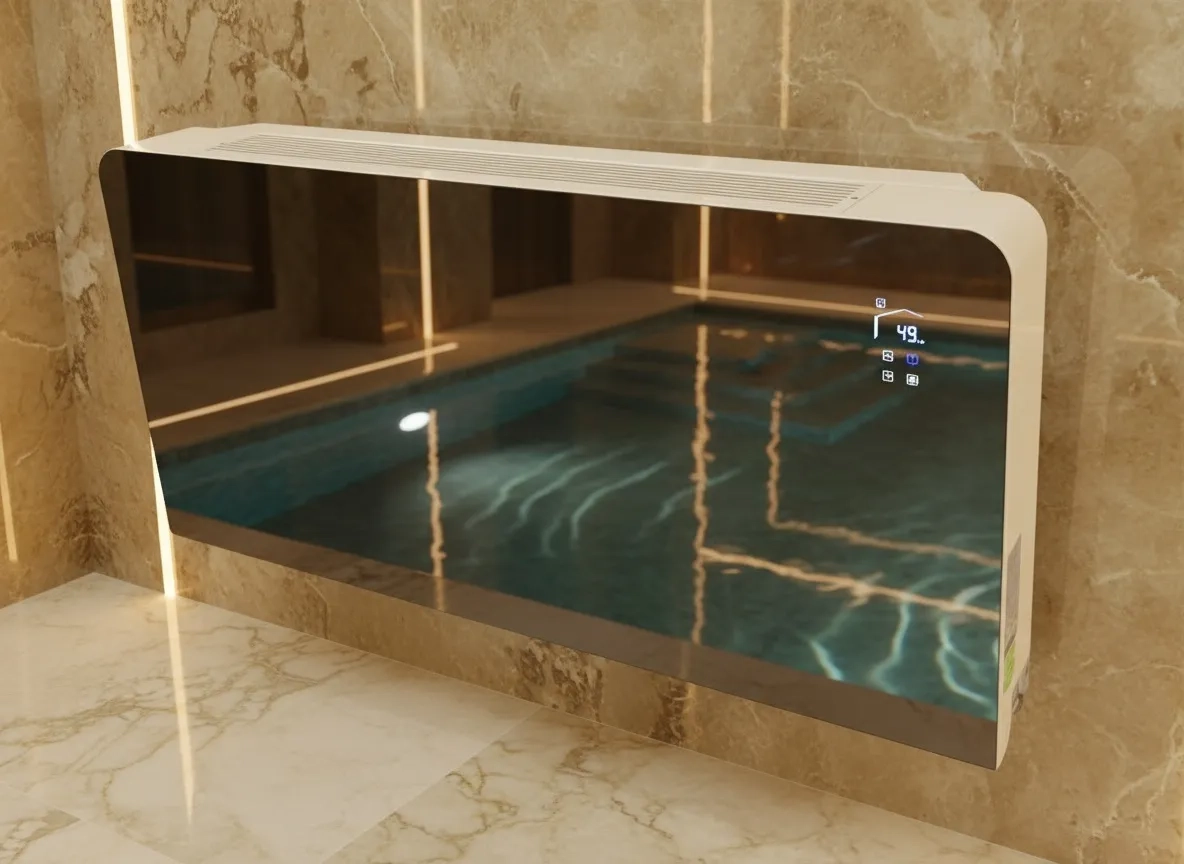
A private pool is luxury and comfort, but it also creates a serious problem: evaporation of dozens of liters of water per day. The consequences of increased humidity are immediately noticeable: fogged-up windows, a musty smell, mold spots on walls and ceilings, corrosion of metal elements. The problem has a clear engineering solution — installing a specialized pool dehumidifier.
A properly selected MBA-G dehumidifier ensures an optimal microclimate in a pool room. You can calculate the required capacity with a simple formula: pool water surface area (m²) × 0.1 = required capacity (L/h). MBA-G dehumidifiers with DC fan motors provide exceptionally quiet operation (44–46 dB), and the gold-colored epoxy coating on the heat exchanger guarantees a long service life even in an aggressive environment.
High humidity problems: real scenarios for pool owners
Imagine waking up on a winter morning and seeing that all the windows in the pool area are completely fogged up. There are puddles of condensate on the windowsills, and black mold spots have already appeared in the corners of the room. This scene is familiar to most private pool owners who have not taken care of a quality air dehumidification system.
The consequences of high humidity go far beyond aesthetic discomfort:
- Condensation on windows — not only reduces visibility but also gradually destroys window frames and sills
- Mold — causes allergic reactions, worsens asthma, and leads to other respiratory diseases
- Corrosion — damages metal structural elements, electrical wiring, and equipment
- Peeling paint and wallpaper — spoils the interior and requires constant repairs
- Unpleasant odor — instead of a fresh smell, the pool is filled with a musty, damp odor
These problems arise when the humidity in the pool room reaches 70–90% instead of the optimal 50–60%, creating an ideal environment for mold growth and accelerating corrosion.
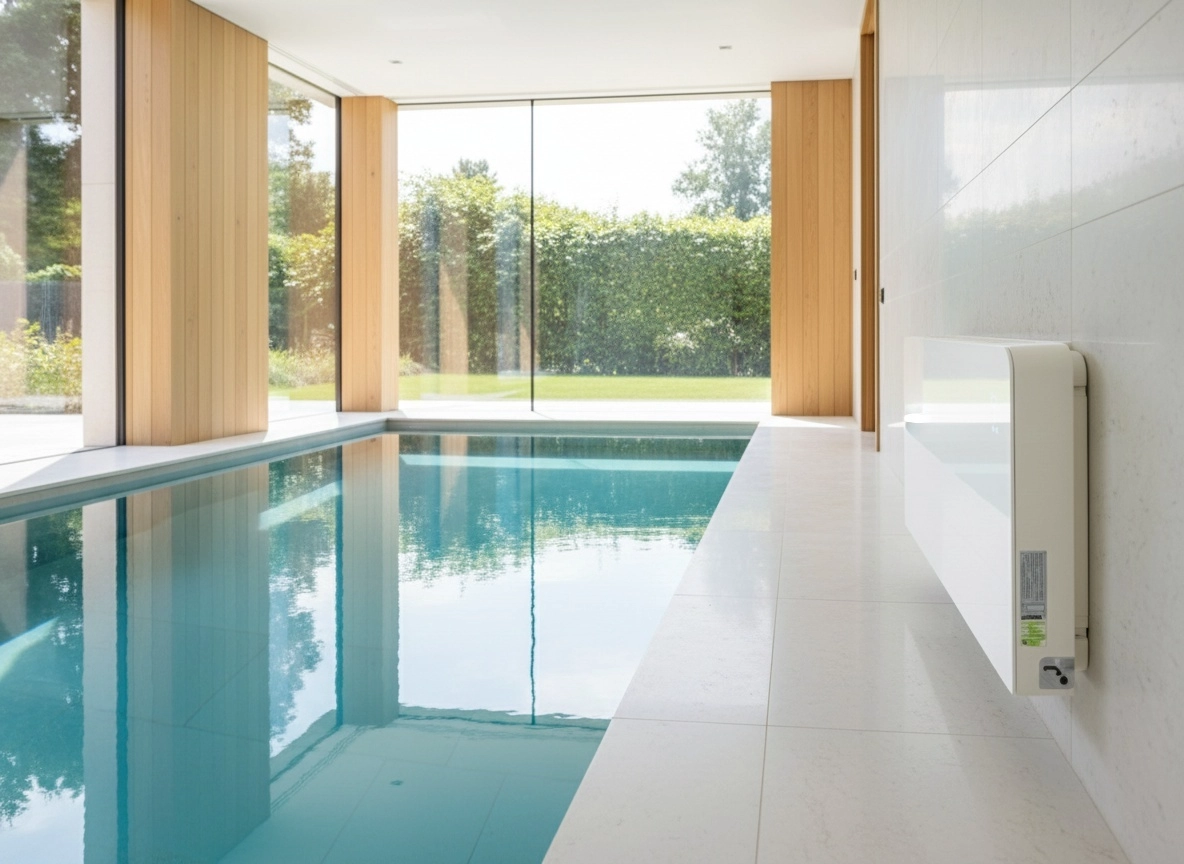
How the MBA-G pool dehumidifier works
The MBA-G dehumidifier operates based on the physical process of moisture condensation from the air. The cycle consists of the following stages:
- A DC fan motor draws humid air from the room
- The air passes through a cold evaporator where moisture condenses
- The condensate is collected and discharged through a drainage system (7 mm tube)
- The dried air passes through the condenser, heats up, and returns to the room
The need for dehumidification arises due to constant water evaporation from the pool surface. Depending on the water temperature, air temperature, and pool usage intensity, 15–28 g of water per hour evaporates from each square meter of the water surface. For a 40 m² pool, this means 0.6–1.1 kg of water per hour or 14–26 liters per day even with moderate use. With active swimming, these figures increase by 2–3 times!
Checklist for choosing the right pool dehumidifier
To choose the right dehumidifier for a pool, consider the following key parameters:
1. Calculating dehumidification capacity
The most important parameter is the dehumidifier capacity, measured in L/h or L/day. For a quick calculation, use the formula:
Pool water surface area (m²) × 0.1 = required capacity (L/h)
Example: for a 40 m² pool, the required capacity is 40 × 0.1 = 4 L/h (approximately 96 L/day). The MBA10G model with a capacity of 4.3 L/h (108 L/day) is suitable.
For a more accurate calculation, you can use the formula: W = e × S × (Pnas - Pust), where e is the evaporation coefficient, S is the pool water surface area, Pnas is the saturated vapor pressure at the water temperature, and Pust is the partial water vapor pressure at the desired indoor humidity.
2. Air volume
The recommended air exchange rate is 1.5 times the room volume per hour. MBA-G models process from 450 to 750 m³/h, depending on the model.
3. Noise level
This is especially important for private pools located in living areas. MBA-G models with DC fan motors operate exceptionally quietly — 44–46 dB(A), which is lower than the level of a quiet conversation.
4. Operating temperature and humidity
MBA-G dehumidifiers operate in the temperature range of 10–32°C and humidity of 40–90% RH, which is ideal for pool rooms where the optimal humidity is 50–60%.
5. Energy consumption
Nominal power consumption ranges from 0.89 to 1.95 kW depending on the model. Maximum — from 1.89 to 2.7 kW.
6. Additional parameters
- R32 refrigerant — environmentally safe, with a low global warming potential
- Epoxy-coated heat exchanger — gold-colored, provides corrosion protection
- Wall-mounted installation — saves space in the room
- Condensate drain pipe diameter — 7 mm, for removing collected moisture
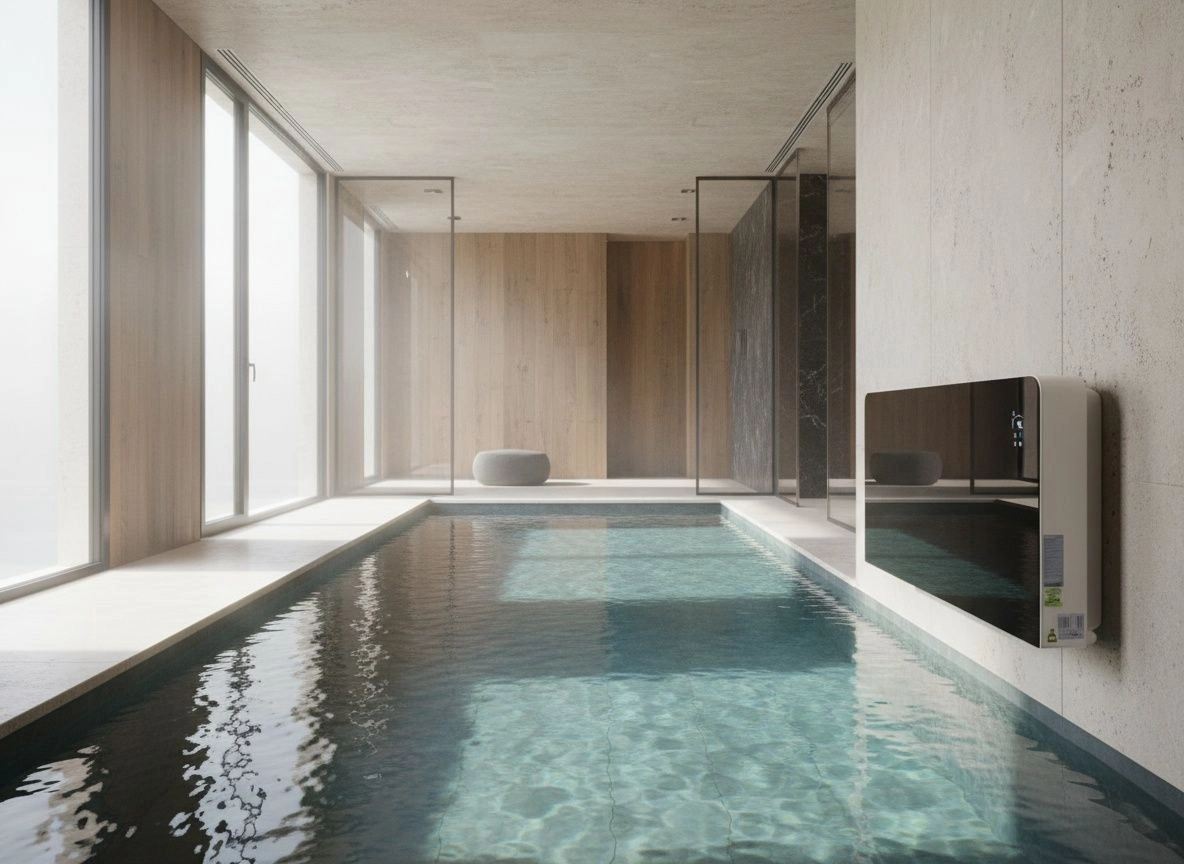
Technical specifications of MBA-G models
The MBA-G series is represented by three models with different capacities for pools of various sizes:
| Specification | MBA05G | MBA07G | MBA10G |
|---|---|---|---|
| Nominal capacity (L/h) | 2.2 | 3.5 | 4.3 |
| Daily dehumidification (L) | 53 | 84 | 108 |
| Airflow (m³/h) | 450 | 600 | 750 |
| Sound level dB(A) | 44 | 44 | 46 |
| Nominal power (kW) | 0.89 | 1.09 | 1.95 |
| Maximum power (kW) | 1.89 | 2.09 | 2.7 |
| Relative humidity (%RH) | 40-90 | 40-90 | 40-90 |
| Operating temperature (°C) | 10-32 | 10-32 | 10-32 |
| Dimensions L×W×H (mm) | 1343×248×790 | 1543×248×790 | 1743×248×790 |
| Refrigerant | R32 | R32 | R32 |
| Condensate drain pipe diameter (mm) | 7 | 7 | 7 |
All performance characteristics are specified at: 30°C, 80% RH.
Key advantages of Mycond MBA-G dehumidifiers
The MBA-G dehumidifier series is designed specifically for private pools and offers several important advantages:
High moisture removal efficiency
Capacity up to 4.3 L/h (108 L/day) at +30°C and 80% humidity allows you to effectively maintain an optimal microclimate even in large pool rooms.
Exceptionally quiet operation
Thanks to the use of DC fan motors, the noise level is only 44–46 dB(A) — lower than moderate rainfall. This allows you to leave the device running even at night without discomfort for residents.
Corrosion protection
The heat exchanger with a gold-colored epoxy coating has excellent hydrophobic properties, ensuring a long service life in the aggressive, humid pool environment.
Compact design
The wall-mounted dehumidifier has a sleek housing that easily fits into the pool room interior without taking up floor space.
Economical operation
Nominal power consumption from 0.89 to 1.95 kW (depending on the model) provides efficient dehumidification with moderate electricity costs.
Environmental safety
The use of R32 refrigerant with a low global warming potential meets modern environmental standards.
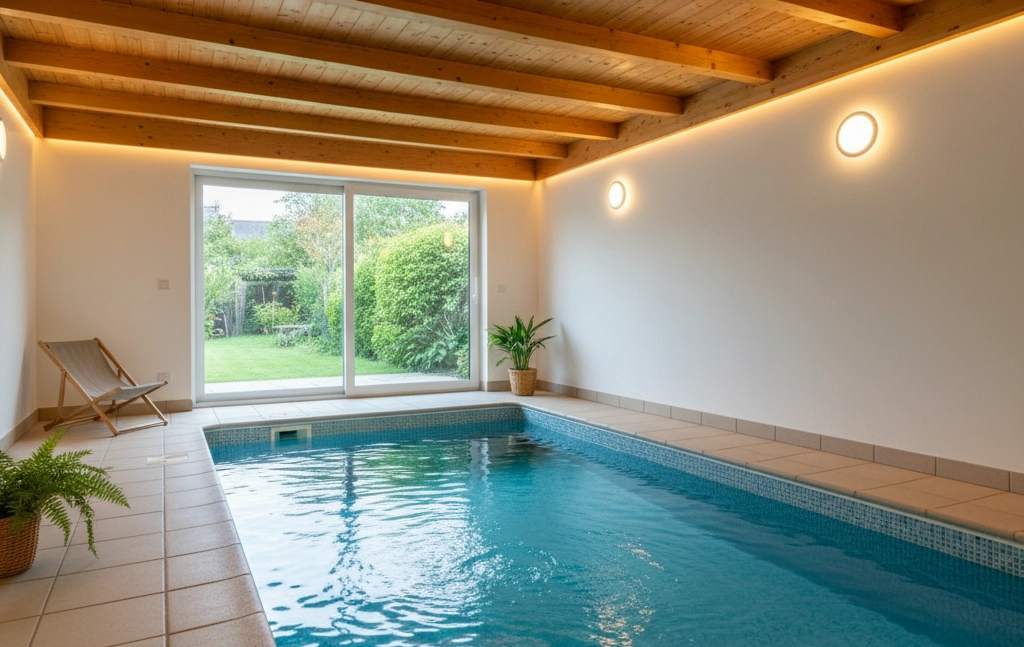
When the MBA-G dehumidifier is the optimal choice
The MBA-G dehumidifier is the ideal solution in the following cases:
- You have a private pool in a living area
- Low noise level during operation is important
- Wall-mounted installation is needed to save space
- Design and aesthetics of the equipment matter
- The pool is used regularly
- Stable operation in high humidity is required
Alternative solutions for pool dehumidification
While MBA-G is the optimal choice for most private pools, there are alternatives that may be appropriate in certain situations:
Portable/home dehumidifiers (12–25 L/day)
Advantages: mobility, ease of use, lower price.
Disadvantages: insufficient capacity for medium and large pools, rapid failure due to the aggressive environment.
Suitable for small pools up to 20 m² or as an additional solution.
Ducted dehumidifiers with concealed installation
Advantages: invisible equipment, uniform air distribution.
Disadvantages: complex installation, higher implementation cost, need for more space for installation.
Optimal for large pools where it is important to keep equipment out of the interior.
Supply and exhaust ventilation with dehumidification
Advantages: a comprehensive solution for air exchange and dehumidification, high level of automation.
Disadvantages: high implementation and operating costs, complex installation.
An ideal choice for large facilities and public pools.
Installation, operation, and maintenance of MBA-G dehumidifiers
Installation
- Wall mounting on brackets
- Distance from the wall — minimum 30 cm to ensure air circulation
- Connection of a 7 mm condensate drain tube for moisture removal
- Electrical connection: 220–240 V~ 50 Hz
Operation
- Set the desired humidity within 50–60% (optimum for a pool)
- Regularly check condensate removal through the drain tube
- Clean the filters every 2–4 weeks
- Do not block the air intake and outlet
Service maintenance
- Annual maintenance
- Check R32 refrigerant
- Clean the epoxy-coated heat exchanger
- Diagnostics of sensors and automation
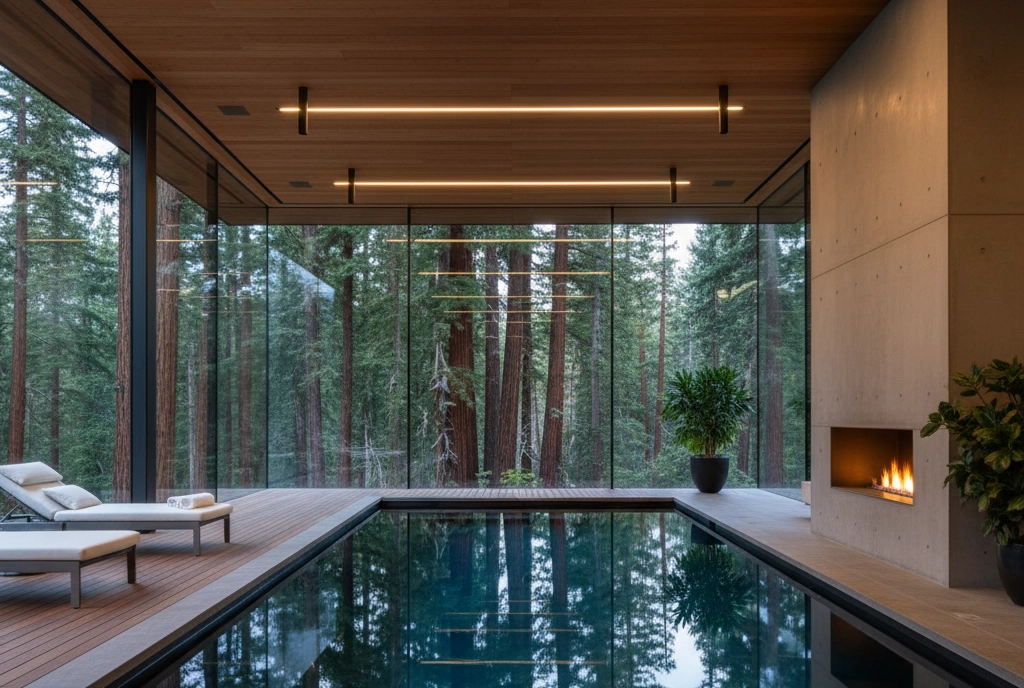
Frequently asked questions about pool dehumidifiers
How to calculate the dehumidifier capacity for a pool?
Use the formula: pool area (m²) × 0.1 = capacity (L/h). For a 6×10 m pool (60 m²): 60 × 0.1 = 6 L/h or about 144 L/day. In this case, the MBA10G with a capacity of 4.3 L/h (108 L/day) is the best fit, possibly with additional ventilation measures.
Why does condensation appear on windows in a pool room?
Water evaporation increases air humidity to 70–90%. When warm, humid air comes into contact with the cold window surface, condensation occurs. A dehumidifier reduces humidity to 50–60%, preventing condensation.
How much electricity does the MBA-G consume?
The MBA05G consumes 0.89 kW nominally (maximum 1.89 kW). At 8 h/day this is about 7 kWh/day or 210 kWh/month. MBA07G and MBA10G consume more in proportion to their capacity.
How loud is the MBA-G dehumidifier?
The noise level is 44–46 dB(A), which corresponds to a quiet conversation or moderate rainfall. Thanks to the DC fan motor, operation is practically whisper-quiet, and you can leave the unit on even at night.
Can I install the MBA-G myself?
It depends on the owner’s technical skills and the specifics of the room. You need to ensure proper wall mounting, connect a 7 mm drain tube, check the electrical connection, and set optimal operating parameters.
What should I do if the dehumidifier can’t keep up with the humidity?
Check the following:
- Is the capacity correctly sized (you may need a higher-capacity model)
- Are the air intake and outlet unobstructed
- Are the filters clean
- Is condensate being removed through the 7 mm drain tube
- Are there additional moisture sources (open showers, sauna without separate ventilation)
What is the difference between MBA05G, MBA07G, and MBA10G?
The main difference is capacity:
- MBA05G: dehumidifies 53 L/day, suitable for small pools
- MBA07G: removes 84 L/day, for medium-sized pools
- MBA10G: the most powerful, 108 L/day, for large pools
They also differ in dimensions (length 1343/1543/1743 mm) and power consumption (0.89/1.09/1.95 kW).
Choosing an MBA-G dehumidifier is an investment in comfort and a healthy indoor climate
Ready to get rid of condensation, mold, and discomfort in your pool? MBA-G dehumidifiers are a professional solution specifically designed for private pools.
- Exceptionally quiet operation: 44–46 dB — below the level of moderate rain
- Compact wall-mounted design that easily fits into the interior
- Reliable corrosion protection: gold-colored epoxy-coated heat exchanger
- Eco-friendly R32 refrigerant
Choose your model:
- MBA05G — for small pools (53 liters per day)
- MBA07G — for medium pools (84 liters per day)
- MBA10G — for large pools (108 liters per day)
Call us or fill out the form on the website for a consultation — our specialists will help calculate the exact capacity for your pool and select the optimal MBA-G air dehumidifier model to ensure the perfect microclimate in your pool for years to come.